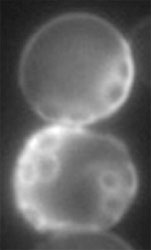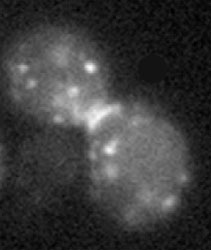Little is known about the mechanism of sorting and packaging of secretory proteins that transit from the Golgi complex to the cell surface. Although some proteins use clathrin to traverse the endosome en route to the plasma membrane, others do not, and, until now, the general view has been that the direct path out of the trans-Golgi network (TGN) may involve tubular carriers formed without the intervention of coat proteins. To examine this limb of the secretory pathway, we have examined two membrane proteins: a biosynthetic enzyme, chitin synthase III (Chs3p), and a mating cell fusion protein, Fus1p, which travel from the TGN/endosome membrane to the plasma membrane in yeast.


Left: Chitin rings stained with calcofluor
Right: Chs3-GFP viewed by fluorescence microscopy (note the presence of Chs3p at both the bud neck and within intracellular compartments)
In cells with mutations that prevent Chs3p from reaching the cell surface, chitin rings and bud neck staining are not present.
Genetic and biochemical analyses have now shown that Chs3p and Fus1p are conveyed from the TGN by a novel coat protein complex we call exomer. The exomer is a large, ~1-MDa complex that binds membranes in the presence of a GTP-activated form of Arf1p, a small GTPase implicated in other coat protein assembly events. Recently, we discovered a novel exomer sorting signal in the cytoplasmic C-terminal domain of Fus1 that directs traffic from the TGN to the cell surface. Unlike other coats, however, exomer is responsible for the traffic of a nonessential set of surface proteins.
Alternative coat proteins may guide secretion and membrane traffic from the TGN to the cell surface in metazoan cells. Although exomer genes are not found outside of eukaryotic microorganisms, the mammalian genome encodes 29 Arf and Arf-like GTPases, several of which are localized to the TGN membrane. We are screening these genes to examine their role in protein traffic from the TGN.
Vesicle Transport Early in the Secretory Pathway